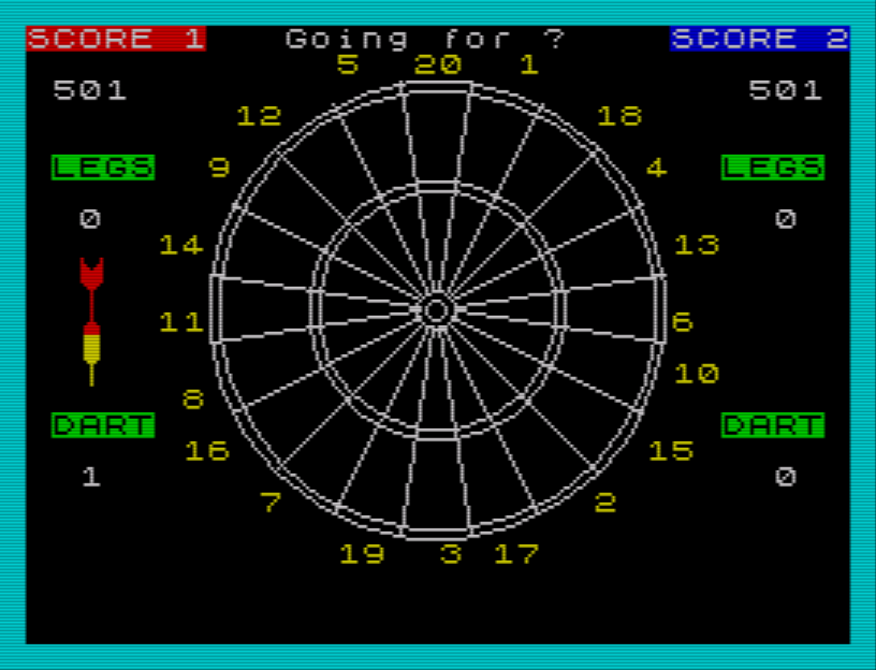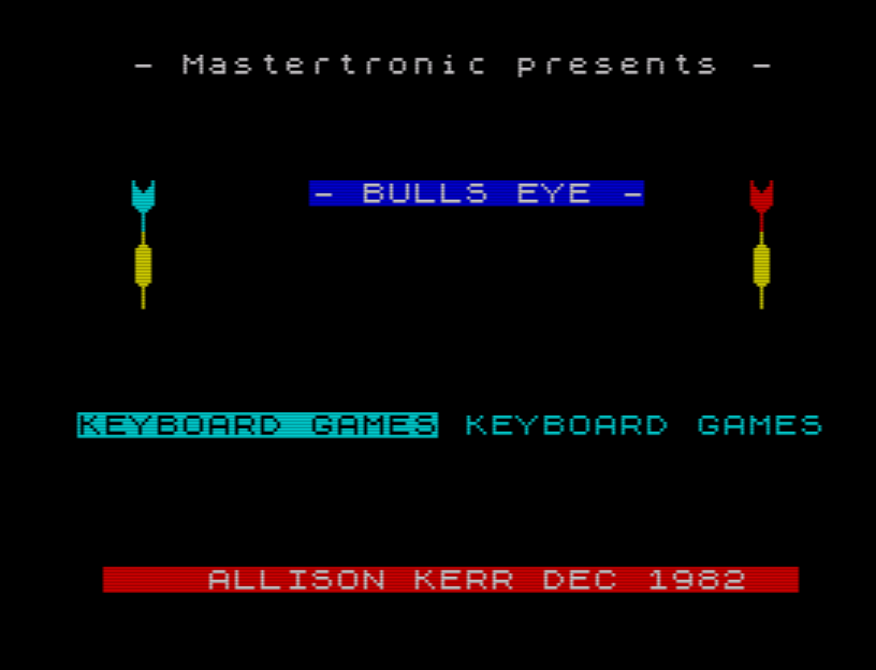
Bullseye, Spectrum, Mastertronic - IS0005
-
Score - 7/107/10
Summary
Computer darts is a slightly weird idea for something that involves real-world physical skill and precision. Yet while this lacks the graphical polish of Mastertronic’s later effort, 180, it has enough complexity of game-type, control and opponent-type to give it a run for its money in delivering good fun playability even now.
User Review
( votes)Mastertronic burst onto the scene in April 1984, revolutionising both where we could buy our games, and how much (or how little!) we had to pay for them. Bullseye was one of the first batch of 14 games published that month, and with its catalogue number of IS0005, it has the honour of being the very first Mastertronic game to appear for the ZX Spectrum. (Although Vegas Jackpot has the catalogue number IS0002, the Spectrum conversion was not actually released until January 1985.)
The Birth Of An Obsession
Just weeks after this launch, as a newly-12-year-old I purposefully made my way to my favourite games shop (which sold not just computer games, but in fact primarily dealt in role-playing games, war games and the endless tiny metal figurines that went with them) clutching ten crisp pounds of birthday money. I had been eyeing up a shiny title from DK’Tronics which I had coveted for several months, costing £5.95.
Whilst paying (and knowing I couldn’t afford a second game), I was immediately interested when I noticed a small rack on the countertop which held a series of futuristic-looking tapes, colour-coded by machine, for only £1.99 each. A quick scan to check this was legit, and I added Bullseye to my purchase….still leaving me enough for a magazine and a chocolate bar at the newsagents on the way back home.
Darts On The Screen
Darts is a little bit of a weird thing to emulate on a computer, since in real life it relies so much on physical skill and balance for good throwing. But this game was not a Mastertronic original: it had previously been released by Mr Chip Software as Darts (or Spectrum Darts). This is instantly given away if you read the inlay: the Mastertronic instructions still say ‘Spectrum Darts will load and run automatically’. Seems like the proof-reader was off that day!
In fact, the game had been written all the way back in December 1982 by Allison Kerr. Curiously, the Mastertronic edition program code credits copyright to ‘Shuttle Soft’ (who were also responsible for Vegas Jackpot), although this text is never actually visible on-screen during the game because the ink and paper colours are the same. (This does not appear in the Mr Chip original, so Shuttle Soft were likely involved in applying the cosmetic changes made for Mastertronic.)
Nevertheless, computer darts makes a change from the endless Pac-Man/Frogger/Invaders clones that were so prevalent at the time, so points for novelty, at least.

Complexity That Belies Its Age
Despite its origins – mere months after the first Spectrum machine was launched – Bullseye (or Bulls Eye as it appears on the title screen) has surprising richness of depth, both in terms of gameplay and controls.
Difficulty involves choosing from three completely different control styles, ranging from ‘type in what you’re aiming for and let the computer figure out if you hit it’, or the slightly more challenging option of using cursor control to get close to your target before releasing the trigger, right through to calculating a height and angle to aim at from the side of the board.
There are five different game types to play as well. These include the classic darts game (called ‘Doubles’ here) where you can choose a starting target between 301 and 1001; Cricket, Noughts And Crosses, Killer and Round The Board. There’s enough variety here to keep you entertained for a few games just to try them all out – but there’s more! On top of this you can choose to play against either computer or human opponents; practice by yourself; or even – 40 years before the current AI craze – watch the computer play against itself.
Playing Bullseye
The game itself is quite challenging even against the computer. The ‘AI’ is not sophisticated, and in practice it comes down to little more than a test of luck. But because of the number of different options you may have to try and check-out, coupled with the possibility of a ‘bust’ if you go over your target, it is still a lot of fun.
However, Bullseye really comes into its own when you play against friends. The random elements act as a great leveller, leaving even the most shaky of novices in with a shout of winning a leg or two. The other game variants also offer enough variety to keep things interesting – I seem to remember having a ‘darts olympics’ with my mates back in the day as we worked our way through the options.

Getting Technical
Bullseye is written in BASIC. It’s a little bit slow and clunky, and certainly doesn’t have the graphical polish of 180 – Mastertronic’s later, and more celebrated attempt at computerising the ol’ arraz. However, it delivers a remarkably good effort for something that was written less than six months into the Spectrum’s existence.
There is no music; but there are sound effects to accompany the game, and whilst they are (literally) basic, they are not overly annoying and help punctuate the play nicely.
Overall
Give it a shot, preferably with friends, and this game that launched the whole MCU (Mastertronic Collecting Universe) – at least on the Spectrum – will still give you a good bit of fun Treble-13 years later.
* * *
You know what we think but why not share your thoughts on this game! Let us know what you think of it in the comments below, or add your own score using the slider in the summary box at the top of the review!


Leave a Reply